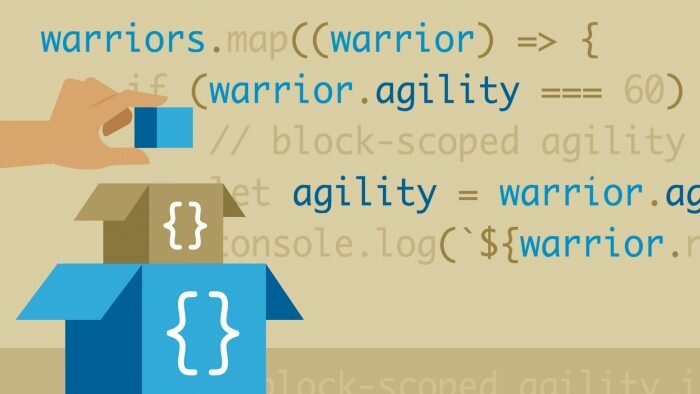If you already know the main concept, the closures are not hard to understand. But it is difficult to understand by reading only theoretical explanations. Our article is for programmers with any experience. For easier understanding, the examples are in javascript.
Closures Explanation
- When a function (
foo) declares other functions (bar and baz), the family of local variables created infoois not destroyed when the function exits. The variables merely become invisible to the outside world.foocan therefore cunningly return the unctionsbarandbaz, and they can continue to read, write and communicate with each other through this closed-off family of variables (“the closure”) that nobody else can meddle with, not even someone who callsfooagain in future. - A closure is one way of supporting first-class functions; it is an expression that can reference variables within its scope (when it was first declared), be assigned to a variable, be passed as an argument to a function, or be returned as a function result.
Closure example 1
The following code returns a reference to a function:
function sayHelloWorld(name) {
var text = 'Hello World ' + name; // Local variable
var sayClosure = function() { console.log(text); }
return sayClosure;
}
var sayMyClosure = sayHelloWorld('one');
sayMyClosure(); // writes "Hello World one"Most javascript developers understand how a reference to a function is returned to a variable (sayMyClosure) in the above code. If you don’t understand, then you need to look at that before you can learn closures. A programmer using C would think of the function as returning a pointer to a function, and that the variables sayClosure and sayMyClosure were each a pointer to a function.
There is a critical difference between a C pointer to a function and a JavaScript reference to a function. In JavaScript, you can think of a function reference variable as having both a pointer to a function as well as a hidden pointer to a closure.
The above code has a closure because the anonymous function function() { console.log(text); } is declared inside another function, sayHelloWorld() in this example. In JavaScript, if you use the function keyword inside another function, you are creating a closure.
In C and most other common languages, after a function returns, all the local variables are no longer accessible because the stack-frame is destroyed.
In JavaScript, if you declare a function within another function, then the local variables of the outer function can remain accessible after returning from it. This is demonstrated above, because we call the function sayMyClosure() after we have returned from sayHelloWorld(). Notice that the code that we call references the variable text, which was a local variable of the function sayHelloWorld().
function() { console.log(text); } // Output of say2.toString();Looking at the output of sayMyClosure.toString(), we can see that the code refers to the variable text. The anonymous function can reference text which holds the value 'Hello World one' because the local variables of sayHelloWorld() have been secretly kept alive in a closure.
The genius is that in JavaScript a function reference also has a secret reference to the closure it was created in – similar to how delegates are a method pointer plus a secret reference to an object.
More examples
Maybe closures seem hard to understand when you read about them, but when you see some examples it becomes clear how they work. Usually I recommend working through the examples carefully until you understand how they work. If you start using closures without fully understanding how they work, you would soon create some very weird bugs!
Example 2
This example shows that the local variables are not copied – they are kept by reference. It is as though the stack-frame stays alive in memory even after the outer function exits!
function someFunction() {
// Local variable that ends up within closure
var value = 100;
var callbackFunction = function() {
console.log(value);
}
value++;
return callbackFunction();
}
someFunction(); // logs 101Example 3
All three global functions have a common reference to the same closure because they are all declared within a single call to setupSomeGlobals().
var gLogNumber, gIncreaseNumber, gSetNumber;
function setupSomeGlobals() {
// Local variable that ends up within closure
var _num = 50;
// Store some references to functions as global variables
gLogNumber = function() {
console.log(_num);
};
gIncreaseNumber = function() {
_num++;
};
gSetNumber = function(x) {
_num = x;
};
}
setupSomeGlobals();
gIncreaseNumber();
gLogNumber(); // 51
gSetNumber(10);
gLogNumber(); // 10
var oldLog = gLogNumber;
setupSomeGlobals();
gLogNumber(); // 50
oldLog() // 10The three functions have shared access to the same closure – the local variables of setupSomeGlobals() when the three functions were defined.
Note that in the above example, if you call setupSomeGlobals() again, then a new closure (stack-frame!) is created. The old gLogNumber, gIncreaseNumber, gSetNumber variables are overwritten with new functions that have the new closure. (In JavaScript, whenever you declare a function inside another function, the inside function(s) is/are recreated again each time the outside function is called.)
Example 4
This example shows that the closure contains any local variables that were declared inside the outer function before it exited. Note that the variable alice is actually declared after the anonymous function. The anonymous function is declared first and when that function is called it can access the alice variable because alice is in the same scope (JavaScript does variable hoisting). Also sayAlice()() just directly calls the function reference returned from sayAlice() — it is exactly the same as what was done previously but without the temporary variable.
function closureTest4() {
var closure = function() {
console.log(_variable);
};
// Local variable that ends up within closure
var _variable = 'Initial Value';
return closure;
}
closureTest4()();// logs "Initial Value"Tricky: note the closure variable is also inside the closure and could be accessed by any other function that might be declared within closureTest4(), or it could be accessed recursively within the inside function.
Example 5
This one is a real gotcha for many people, so you need to understand it. Be very careful if you are defining a function within a loop: the local variables from the closure may not act as you might first think.
You need to understand the “variable hoisting” feature in Javascript in order to understand this example.
function buildList(list) {
var result = [];
for (var i = 0; i < list.length; i++) {
var item = 'item' + i;
result.push( function() {
console.log(item + ' ' + list[i]);
} );
}
return result;
}
function testList() {
var fnlist = buildList([1,2,3,4]);
// Using j only to help prevent confusion -- could use i.
for (var j = 0; j < fnlist.length; j++) {
fnlist[j]();
}
}
testList(); //logs "item3 undefined" 4 timesThe line result.push( function() {console.log(item + ' ' + list[i])} adds a reference to an anonymous function four times to the result array. If you are not so familiar with anonymous functions think of it like:
pointer = function() {console.log(item + ' ' + list[i])};
result.push(pointer);Note that when you run the example, "item3 undefined" is logged four times! This is because just like previous examples, there is only one closure for the local variables for buildList (which are result, i, list and item). When the anonymous functions are called on the line fnlist[j](); they all use the same single closure, and they use the current value for i and item within that one closure (where i has a value of 4 because the loop had completed, and item has a value of 'item3'). Note we are indexing from 0 hence item has a value of item3. And the i++ will increment i to the value 4.
It may be helpful to see what happens when a block-level declaration of the variable item is used (via the let keyword) instead of a function-scoped variable declaration via the var keyword. If that change is made, then each anonymous function in the array result has its own closure; when the example is run the output is as follows:
item0 undefined
item1 undefined
item2 undefined
item3 undefinedIf the variable i is also defined using let instead of var, then the output is:
item0 1
item1 2
item2 3
item3 4Example 6
In this final example, each call to the main function creates a separate closure.
function newClosure(someNum, someRef) {
// Local variables that end up within closure
var num = someNum;
var anArray = [1,2,3];
var ref = someRef;
return function(x) {
num += x;
anArray.push(num);
console.log('num: ' + num +
'; anArray: ' + anArray.toString() +
'; ref.someVar: ' + ref.someVar + ';');
}
}
obj = {someVar: 4};
fn1 = newClosure(4, obj);
fn2 = newClosure(5, obj);
fn1(1); // num: 5; anArray: 1,2,3,5; ref.someVar: 4;
fn2(1); // num: 6; anArray: 1,2,3,6; ref.someVar: 4;
obj.someVar++;
fn1(2); // num: 7; anArray: 1,2,3,5,7; ref.someVar: 5;
fn2(2); // num: 8; anArray: 1,2,3,6,8; ref.someVar: 5;Summary
If everything seems completely unclear, then the best thing to do is to play with the examples. Reading an explanation is much harder than understanding examples. My explanations of closures and stack-frames, etc. are not technically correct – they are gross simplifications intended to help to understand. Once the basic idea is grokked, you can pick up the details later.
Final points:
- Whenever you use
functioninside another function, a closure is used. - Whenever you use
eval()inside a function, a closure is used. The text youevalcan reference local variables of the function, and withinevalyou can even create new local variables by usingeval('var foo = …') - When you use
new Function(…)(the Function constructor) inside a function, it does not create a closure. (The new function cannot reference the local variables of the outer function.) - A closure in JavaScript is like keeping a copy of all the local variables, just as they were when a function exited.
- It is probably best to think that a closure is always created just an entry to a function, and the local variables are added to that closure.
- A new set of local variables is kept every time a function with a closure is called (given that the function contains a function declaration inside it, and a reference to that inside function is either returned or an external reference is kept for it in some way).
- Two functions might look like they have the same source text, but have completely different behavior because of their ‘hidden’ closure. I don’t think JavaScript code can actually find out if a function reference has a closure or not.
- If you are trying to do any dynamic source code modifications (for example:
myFunction = Function(myFunction.toString().replace(/Hello/,'Hola'));), it won’t work ifmyFunctionis a closure (of course, you would never even think of doing source code string substitution at runtime, but…). - It is possible to get function declarations within function declarations within functions… and you can get closures at more than one level.
- I think normally a closure is a term for both the function along with the variables that are captured. Note that I do not use that definition in this article!
- I suspect that closures in JavaScript differ from those normally found in functional languages.







